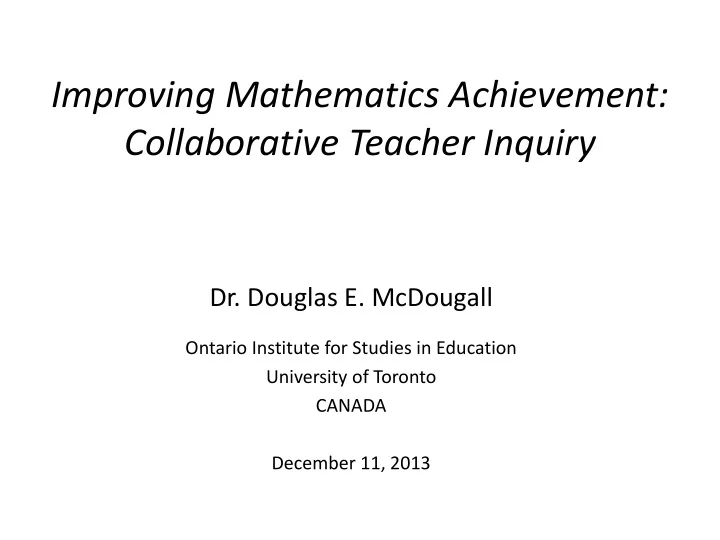

Improving Mathematics Achievement: Collaborative Teacher Inquiry Dr. Douglas E. McDougall Ontario Institute for Studies in Education University of Toronto CANADA December 11, 2013
Project Overview • Focus on Grade 9 Applied level Mathematics • Timeline: – Phase 1 December 2008 – May 2010 – Phase 2 December 2010 – June 2012 • Comprised of: – Time for collaboration – Implementation school teams – Participation from central program staff – Professional development sessions – Visits to schools – Administrator meetings 1
Research Goals 1. To improve the teaching the learning of Grade 9 Applied Mathematics 2. To investigate the use of the Ten Dimensions of Mathematics Education (McDougall, 2004) framework to improve student achievement in secondary school mathematics 3. To investigate collaborative inquiry as a professional development strategy 2
Method • Qualitative – School visits - implementation teams, administrators – Professional development sessions – Teacher and team surveys – Teacher interviews • Quantitative – EQAO (large-scale assessment) scores and credit accumulation in June – 1st term and final grade results 3
Ten Dimensions 1. Program Scope and Planning • Starting with measurement, splitting up strands • Scheduling • Class length • Common planning time • Organize EQAO questions by unit/chapter • Resources – edugains, TIPS, course packages • Continuity to Grade 10
Ten Dimensions 3. Learning Environment • Classroom organization – cluster of tables • Word walls • Peer tutoring • Same room for all sections of Grade 9 Applied • Wall mounted SMART board
Ten Dimensions 4. Student Tasks • Integrating TIPS resources • Integrating EQAO questions – introductory activity, unit tests, investigations • Meaningful and engaging practice • Meaningful contexts • Class length to complete tasks
Ten Dimensions 7. Manipulatives and Technology • Appropriate use of a variety of manipulatives • Use of computer labs • Use of Docucamera • Use of Gizmos and Clips resources • Technology Infrastructure
Ten Dimensions 9. Assessment • Variety of assessment strategies/tools • Transparency • Use of diagnostic tests • Common evaluation and assessment tasks
Ten Dimensions 10. Teacher ’ s Attitude and Comfort with Mathematics • Modeling a positive attitude • Increased comfort with math content knowledge • Professional development workshops • Teachers planning together • Collaboration
Collaboration • Mathematics Implementation teams at each school – administrator, department head/curriculum leader, teachers of Grade 9 Applied mathematic courses • Team teaching, co-teaching, peer coaching • Supporting special needs students • Wiki – technology collaboration
Data show improvement • Credit accumulation: – 70.8% to 86.1% (average increase 22%) – four schools less than 10%, five schools 18% to 32%, one school 91% • Provincial tests: – 108% increase in EQAO average scores – One school with 256% – Three schools over 150 % increase 11
Summary • Encouraging EQAO results • Increase in credit accumulation • More teacher collaboration • Teachers realize that they can make a real difference in student achievement • Teachers empowered with more confidence to implement strategies new to them 12
Grade 8 • Eight Feeder Schools – September 2012 – Present – One school district – Same process as the Grade 9 project – Early Comments • Increased use of ONAP materials, moderated marking, use of success criteria • Challenges – scheduling of collaboration time, teacher continuity, content knowledge for integration of strands 13
Future • 1. What innovative pedagogical practices were sustained and/or lost in the years following the project? • 2. What factors contributed to the persistence or loss of these practices? • 3. What components of the professional development program enhance sustainability? 14
doug.mcdougall@utoronto.ca 15
Ten Dimensions 2. Meeting Individual Needs • Using a variety of instructional approaches • Strategies for differentiating instruction • After school numeracy classes
Ten Dimensions 5. Constructing Knowledge • Appropriate instructional approaches • Use of effective questions • Understanding how students construct knowledge
Ten Dimensions 6. Communicating with Parents • about their child ’ s progress • about the mathematics program • in a variety of ways to engage support
Ten Dimensions 8. Students ’ Mathematical Communication • Oral • Written • Graphic/pictorial • Physical • Encouraging student talk about math
Recommend
More recommend